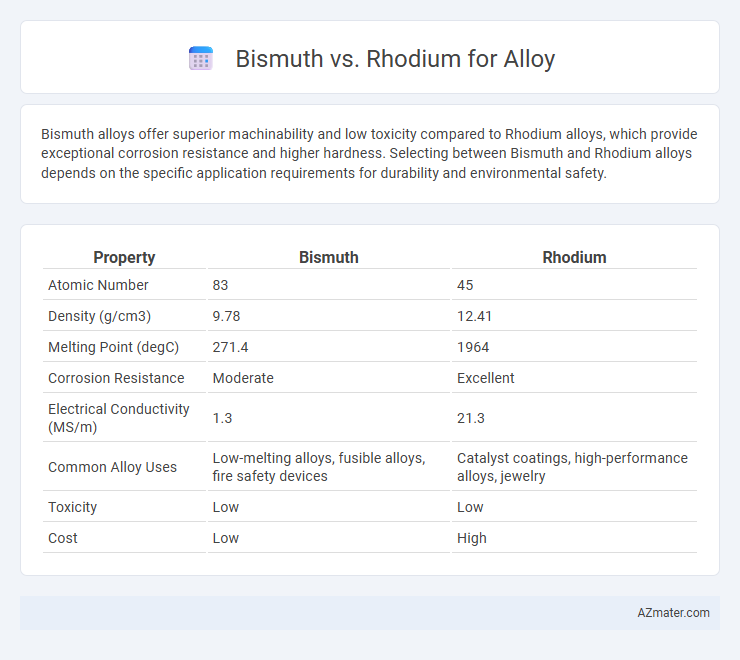Bismuth alloys offer superior machinability and low toxicity compared to Rhodium alloys, which provide exceptional corrosion resistance and higher hardness. Selecting between Bismuth and Rhodium alloys depends on the specific application requirements for durability and environmental safety.
Table of Comparison
| Property | Bismuth | Rhodium |
|---|---|---|
| Atomic Number | 83 | 45 |
| Density (g/cm3) | 9.78 | 12.41 |
| Melting Point (degC) | 271.4 | 1964 |
| Corrosion Resistance | Moderate | Excellent |
| Electrical Conductivity (MS/m) | 1.3 | 21.3 |
| Common Alloy Uses | Low-melting alloys, fusible alloys, fire safety devices | Catalyst coatings, high-performance alloys, jewelry |
| Toxicity | Low | Low |
| Cost | Low | High |
Introduction to Bismuth and Rhodium Alloys
Bismuth and rhodium alloys each offer distinct properties valuable in specialized industrial applications. Bismuth alloys are prized for their low melting points, non-toxicity, and unique expansion characteristics, making them ideal for use in fusible plugs and fire safety devices. Rhodium alloys, known for exceptional corrosion resistance and high hardness, are commonly utilized in high-performance electrical contacts and catalytic converters, providing enhanced durability under extreme conditions.
Chemical Properties: Bismuth vs Rhodium
Bismuth exhibits low toxicity, a high density of 9.78 g/cm3, and a melting point of 271.5degC, making it a stable, brittle metal often used to improve machinability in alloys. Rhodium, with a melting point of 1964degC and a density of 12.41 g/cm3, offers exceptional corrosion resistance and hardness, essential for catalytic converters and high-temperature applications. The chemical inertness of rhodium contrasts with bismuth's tendency to oxidize under strong acidic conditions, influencing their respective roles in alloy formulations.
Physical Characteristics and Appearance
Bismuth exhibits a low density of 9.78 g/cm3 and a melting point of 271.5degC, characterized by a brittle, crystalline structure with a distinctive iridescent, silver-pink hue. Rhodium, significantly denser at 12.41 g/cm3, has a much higher melting point of 1,964degC and presents a hard, durable, silvery-white appearance often used for reflective coatings. The substantial difference in melting points and density between Bismuth and Rhodium affects their alloying behavior, with Rhodium providing superior hardness and corrosion resistance compared to the more brittle, visually striking Bismuth.
Alloying Behavior and Compatibility
Bismuth exhibits limited solubility and poor compatibility with most metals, often causing embrittlement in alloys, particularly with copper, thereby reducing mechanical integrity. Rhodium demonstrates strong alloying behavior with platinum-group metals, enhancing corrosion resistance and mechanical strength without compromising ductility. When comparing Bismuth and Rhodium in alloy formation, Rhodium offers superior compatibility and stability, making it more suitable for high-performance and corrosion-resistant applications.
Mechanical Strength and Durability
Rhodium exhibits superior mechanical strength and durability compared to bismuth when used in alloys, offering enhanced resistance to deformation and wear under high-stress conditions. Rhodium's exceptional hardness and corrosion resistance make it ideal for applications requiring long-lasting durability, while bismuth alloys tend to be softer and more brittle, limiting their performance in demanding mechanical environments. The high melting point and stability of rhodium also contribute to its favorable mechanical properties in alloy compositions.
Applications in Industry and Technology
Bismuth alloys are widely used in low-melting-point applications such as fire detection systems, fusible plugs, and environmentally friendly solders due to their non-toxic and expansion properties upon solidification. Rhodium alloys exhibit exceptional corrosion resistance and high hardness, making them ideal for catalytic converters, electrical contacts, and high-performance coatings in automotive and chemical industries. Choosing between bismuth and rhodium alloys depends on balancing cost-efficiency, melting point requirements, and durability in extreme environments.
Cost and Market Availability
Bismuth is significantly more affordable than rhodium, making it a cost-effective choice for alloy production. Rhodium, being one of the rarest and most expensive precious metals, has limited market availability, leading to higher prices and potential supply constraints. This scarcity contrasts with bismuth's broader accessibility and stable supply chain, influencing decision-making in alloy manufacturing.
Environmental and Health Considerations
Bismuth, known for its low toxicity and non-carcinogenic properties, provides a safer alternative to rhodium in alloy production, minimizing environmental and occupational health risks. Rhodium, a rare and expensive precious metal, poses significant environmental concerns due to intensive mining processes and potential toxic exposure during alloy manufacturing. Selecting bismuth alloys reduces hazardous waste and lowers the carbon footprint compared to rhodium-based alloys, supporting sustainable and eco-friendly metallurgical practices.
Performance in High-Temperature Environments
Rhodium exhibits superior oxidation resistance and maintains mechanical strength at temperatures exceeding 1,000degC, making it ideal for high-temperature alloy applications. Bismuth alloys, while offering low melting points and excellent machinability, suffer from diminished performance and brittleness under elevated thermal conditions. The enhanced thermal stability and corrosion resistance of rhodium alloys significantly outperform bismuth counterparts in harsh, high-temperature environments.
Future Prospects: Bismuth vs Rhodium Alloys
Bismuth alloys show promising future prospects due to their environmentally friendly, non-toxic nature and excellent machinability, making them ideal for biodegradable applications and lead-free alternatives in electronics. Rhodium alloys, with their outstanding corrosion resistance, high hardness, and superior catalytic properties, remain crucial in high-performance automotive catalytic converters and jewelry, but their rarity and high cost limit widespread adoption. Innovations in alloy composition and recycling methods are expected to enhance the economic viability and sustainability of both bismuth and rhodium alloys in advanced industrial applications.

Infographic: Bismuth vs Rhodium for Alloy
 azmater.com
azmater.com